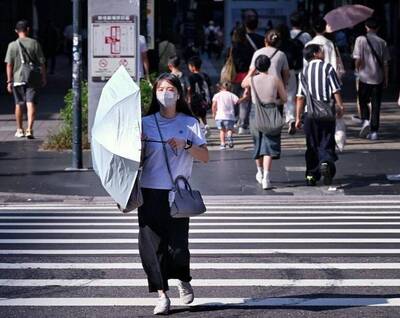This year’s special examination for consular and diplomatic personnel does not have any exam groups for Southeast Asian languages, despite the government’s “new southbound policy” that aims to improve relations with Southeast Asian nations.
The nation’s diplomats have to pass the examination to begin their training, with the exam being divided into different language groups, but this year’s exam brochure listed English, French, Japanese and German among other non-Southeast Asian languages.
In response to queries about the lack of an exam group for Southeast Asian languages, an official at the Ministry of Foreign Affairs said that it has been sending its personnel to Southeast Asian nations to learn their languages each year and it would continue the policy instead of opening language groups in the entrance exam.
Regulations stipulate that the ministry would recruit 30 to 40 diplomatic personnel through the exam.
The available positions are divided into several language groups. The 42 positions opened this year are divided into 10 language groups: English, French, German, Japanese, Spanish, Arabic, Korean, Russian, Italian and Portuguese, with 26 positions for English, amounting to about 60 percent of all positions, while the other groups each have one or two open positions.
The ministry said the number of teachers and graduates of Southeast Asian languages in the nation are limited and the nation’s diplomatic scale is small to medium, so it would be “unfair” if each new diplomatic personnel would only be sent to one nation.
The ministry said that it has its personnel learn Southeast Asian languages as a second foreign language by sending them to Southeast Asian nations and holding language classes at its Institute of Diplomacy and International Affairs, adding that it would continue to implement the method next year.
Democratic Progressive Party (DPP) Legislator Karen Yu (余宛如) said that language is the starting point of communication, adding: “We say we want to go south, but we do not respect their languages.”
Yu said she hopes the examination would open positions for people fluent in Southeast Asian languages to create demand, so that the supply would increase.
DPP Legislator Chung Chia-pin (鍾佳濱) said the lack of such positions this year is the result of the previous government’s policies, so he would not criticize the ministry, but added that the ministry should actively provide chances and attract such talent in the future to coordinate with the new policy.
Chung said that many women from Southeast Asian nations live in Taiwan and their children — “Taiwan’s new children” — are the best candidates for diplomats, so the government should establish scholarships to encourage students to learn about Southeast Asian affairs.
President Tsai Ing-wen (蔡英文) on Wednesday last week approved the guidelines for establishing the “new southbound policy office,” which is to operate under the Presidential Office budget.
James Huang (黃志芳), a former foreign minister who has been designated to head the policy office, said that the goal of the policy is to “turn ASEAN into an extension of Taiwan’s domestic market.”
According to the Presidential Office, the policy office will be a task force whose staff members will come from the Presidential Office or other government agencies, either on special assignments or on loan.
Additonal reporting by CNA

Foreign travelers entering Taiwan on a short layover via Taiwan Taoyuan International Airport are receiving NT$600 gift vouchers from yesterday, the Tourism Administration said, adding that it hopes the incentive would boost tourism consumption at the airport. The program, which allows travelers holding non-Taiwan passports who enter the country during a layover of up to 24 hours to claim a voucher, aims to promote attractions at the airport, the agency said in a statement on Friday. To participate, travelers must sign up on the campaign Web site, the agency said. They can then present their passport and boarding pass for their connecting international

Temperatures in northern Taiwan are forecast to reach as high as 30°C today, as an ongoing northeasterly seasonal wind system weakens, the Central Weather Administration (CWA) said. CWA forecaster Tseng Chao-cheng (曾昭誠) said yesterday that with the seasonal wind system weakening, warmer easterly winds would boost the temperature today. Daytime temperatures in northern Taiwan and Yilan County are expected to range from 28°C to 30°C today, up about 3°C from yesterday, Tseng said. According to the CWA, temperature highs in central and southern Taiwan could stay stable. However, the weather is expected to turn cooler starting tonight as the northeasterly wind system strengthens again

COOLING OFF: Temperatures are expected to fall to lows of about 20°C on Sunday and possibly 18°C to 19°C next week, following a wave of northeasterly winds on Friday The Central Weather Administration (CWA) on Sunday forecast more rain and cooler temperatures for northern Taiwan this week, with the mercury dropping to lows of 18°C, as another wave of northeasterly winds sweeps across the country. The current northeasterly winds would continue to affect Taiwan through today, with precipitation peaking today, bringing increased rainfall to windward areas, CWA forecaster Liu Pei-teng (劉沛滕) said. The weather system would weaken slightly tomorrow before another, stronger wave arrives on Friday, lasting into next week, Liu said. From yesterday to today, northern Taiwan can expect cool, wet weather, with lows of 22°C to 23°C in most areas,

Taiwan sweltered through its hottest October on record, the Central Weather Administration (CWA) said yesterday, the latest in a string of global temperature records. The main island endured its highest average temperature since 1950, CWA forecaster Liu Pei-teng said. Temperatures the world over have soared in recent years as human-induced climate change contributes to ever more erratic weather patterns. Taiwan’s average temperature was 27.381°C as of Thursday, Liu said. Liu said the average could slip 0.1°C by the end of yesterday, but it would still be higher than the previous record of 27.009°C in 2016. "The temperature only started lowering around Oct. 18 or 19